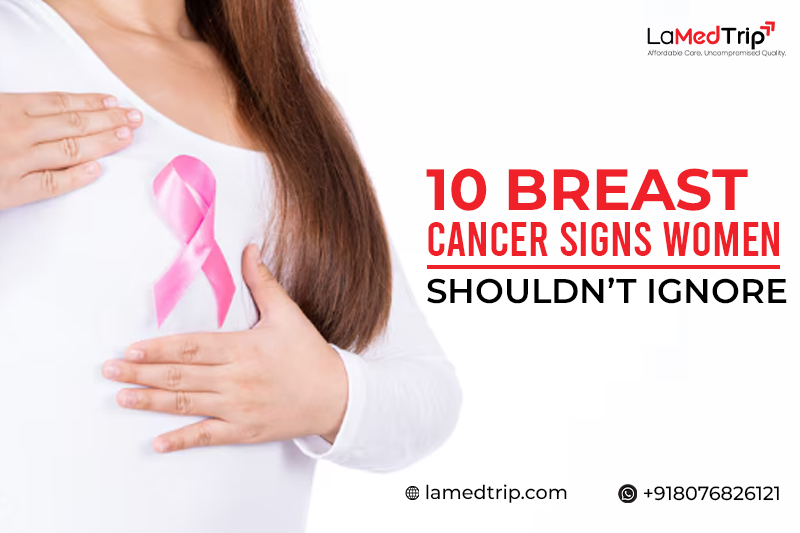
For many women, breast health is something that often takes a back seat to the busyness of everyday life. But the truth is, breast cancer doesn’t wait. It is one of the most common cancers in women worldwide, and early detection is the single most powerful tool in beating it. The challenge is that the warning signs are often subtle, and too many women brush them off as “nothing serious” until it’s too late.
At LaMedTrip, we see this story unfold all too often. Women who wish they had paid attention earlier, families who wish they had acted faster. Yet, we also witness incredible turnarounds every single day when the disease is caught in time. That’s why awareness is not just important; it can be life-saving.
In this article, we’ll explore the top 10 breast cancer symptoms every woman should be alert to, why these changes matter, and how access to advanced care—often more affordable than people realize—can transform outcomes.

Breast cancer is not a single disease. There are several breast cancer types, ranging from slow-growing tumors to aggressive forms like triple-negative or inflammatory cancer. The earlier you spot the signs, the greater the chances of successful treatment, especially in the initial breast cancer stages when it’s still localized.
Think of it like a fire in a house. A spark is easier to put out than an inferno. In the same way, detecting the smallest shift in your breast health can be the spark that prompts you to seek medical help—and stop the disease before it spreads.
This is often the first symptom women notice. Not every lump is cancerous, but if you feel a firm, irregular growth in your breast or armpit, don’t wait. Schedule a check-up right away.
If one breast starts looking different from the other—whether larger, smaller, or oddly contoured—your body is sending you a message that shouldn’t be dismissed.
Ongoing discomfort in the breast or armpit area that lingers for weeks needs investigation. Some forms of breast cancer present this way, even when no lump is obvious.
An inverted nipple that wasn’t inverted before, a change in position, or a sudden flattening may point to something deeper than just hormonal shifts.
Clear, bloody, or unusual discharge that isn’t breast milk is never normal and should be taken seriously.
Dimpling, puckering, redness, or a rash-like appearance are warning signs. The skin may even start to resemble the texture of an orange peel, a symptom linked with inflammatory breast cancer types.
Cancer often spreads first to nearby lymph nodes. Swelling in these areas, even without a breast lump, is cause for an urgent check-up.
A new vein pattern that suddenly becomes noticeable could indicate that a tumor is changing blood flow beneath the surface.
Many women mistake this for a skin irritation. But if itching, burning, or redness continues without relief, it’s worth ruling out a deeper cause.
In later breast cancer stages, the body often shows more generalized symptoms. If you feel constantly drained, and the pounds slip away without dieting, it’s time to consult a doctor.

Breast cancer is not one-size-fits-all. Some tumors grow slowly and can be removed surgically with minimal follow-up, while others spread rapidly and require aggressive combinations of chemotherapy, radiation, and targeted therapies.
The key point? Breast cancer treatment is always more effective—and often less invasive—when started early. That is why listening to your body matters so much.
A breast cancer diagnosis is overwhelming, and one of the biggest worries patients have is cost. Treatment in Western countries can run into hundreds of thousands of dollars, creating stress on top of an already difficult situation.
This is where India has become a trusted global destination:
For many women and their families, this combination of quality and affordability is life-changing.
No one can completely prevent breast cancer, but you can reduce your risk. Simple lifestyle changes, when combined with regular screening, go a long way:
Awareness is your first line of defense. Regular screening is your second. Together, they create a strong shield of breast cancer prevention.
At LaMedTrip, we don’t just connect patients to hospitals—we walk with you on the entire journey. From the moment you reach out, you’ll know you are not alone. Our team ensures you understand your options, compares treatment packages, and helps you access care that fits your needs and budget.
Choosing LaMedTrip means:
Your health is too valuable to ignore. The signs we’ve outlined are not meant to cause fear but to encourage action. The earlier you take that action, the stronger your chances of recovery.
Remember this: listening to your body is not overreacting—it’s protecting your future. And if you or a loved one is diagnosed, know that world-class, affordable care is within reach at a cancer hospital in India, with LaMedTrip guiding you every step of the way.

Question 1: What is the most common early symptom of breast cancer?
Answer: A painless lump in the breast or underarm is the most frequently reported early symptom.
Question 2: How do breast cancer types affect treatment?
Answer: Each type requires a different approach. For example, hormone-sensitive cancers may respond to hormone therapy, while aggressive cancers need intensive chemotherapy.
Question 3: What is the average cost of treatment in India?
Answer: Depending on the hospital and treatment plan, patients can save up to 70 percent compared to costs in the US or UK.
Question 4: How often should women get screened?
Answer: Women over 40 should get annual mammograms. Those with a family history may need earlier and more frequent checks.
Question 5: Why should I choose treatment in India through LaMedTrip?
Answer: You gain access to top hospitals, affordable care, and full support in navigating your medical journey from start to finish.